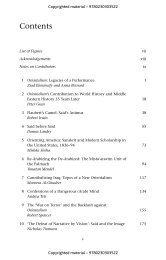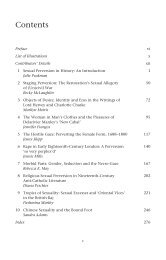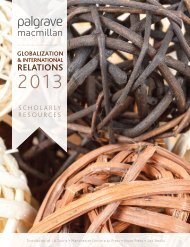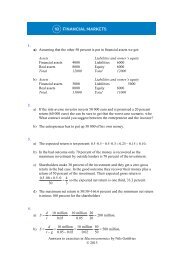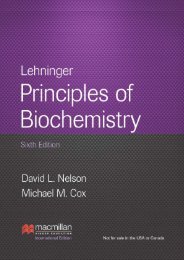The Nameless Shamelessness of Ulysses - Palgrave
The Nameless Shamelessness of Ulysses - Palgrave
The Nameless Shamelessness of Ulysses - Palgrave
Create successful ePaper yourself
Turn your PDF publications into a flip-book with our unique Google optimized e-Paper software.
<strong>The</strong> ‘nameless shamelessness’ <strong>of</strong> <strong>Ulysses</strong> 45<br />
8. For a summary <strong>of</strong> many <strong>of</strong> the legal issues involving copyright and <strong>Ulysses</strong> see<br />
Robert Spoo, ‘Injuries, Remedies, Moral Rights, and the Public Domain’, James<br />
Joyce Quarterly, 37 (2000): 333–66. Spoo’s argument that the 1922 edition <strong>of</strong><br />
<strong>Ulysses</strong> may, in fact, not have copyright protection in the United States appears<br />
in Spoo, ‘Copyright and the Ends <strong>of</strong> Ownership: the Case for a Public Domain<br />
<strong>Ulysses</strong> in America’, in Joyce Studies Annual 1999, ed. Thomas F. Staley (Austin:<br />
University <strong>of</strong> Texas Press, 1999), 5–62.<br />
9. Pierre Bourdieu, <strong>The</strong> Rules <strong>of</strong> Art: Genesis and Structure <strong>of</strong> the Literary Field (Stanford:<br />
Stanford University Press, 1996), 47.<br />
10. Paul Saint-Amour, <strong>The</strong> Copywrights: Intellectual Property and the Literary Imagination<br />
(Ithaca: Cornell University Press, 2003).<br />
11. Hugh Kenner, ‘Joyce and Modernism’, in James Joyce, ed. Harold Bloom<br />
(Philadelphia: Chelsea House, 2003), 101.<br />
12. Cited in Frank Budgen, James Joyce and the Making <strong>of</strong> <strong>Ulysses</strong> (New York: Harrison<br />
Smith and Robert Hass, 1934), 69.<br />
13. James Joyce, Finnegans Wake (New York: Penguin, 1939), 179, 182.<br />
14. Cited in Richard Ellmann, James Joyce (Oxford: Oxford University Press, 1982),<br />
310. <strong>The</strong> various manuscript copies <strong>of</strong> the story contain different versions <strong>of</strong> this<br />
passage, which was continually rewritten in an effort to secure publication. For<br />
a full record see <strong>The</strong> James Joyce Archive, ed. Michael Groden et al. (New York:<br />
Garland, 1977–1979), 4: 181–269. <strong>The</strong> final version <strong>of</strong> the text simply refers to<br />
Queen Victoria as Edward VII’s ‘old mother’. James Joyce, Dubliners (New York:<br />
Viking, 1967), 132.<br />
15. Joyce, Dubliners, 132.<br />
16. Ellmann, 314.<br />
17. Ellmann, 315.<br />
18. James Joyce, Letters <strong>of</strong> James Joyce (New York: Viking, 1966), 2: 291.<br />
19. Francis Holt, <strong>The</strong> Law <strong>of</strong> Libel (London: W. Reed, 1812), 84.<br />
20. Ellmann, 328.<br />
21. Ellmann, 329–30.<br />
22. Collected Letters <strong>of</strong> James Joyce, 1:64.<br />
23. Parmiter v. Coupland, 151 Eng. Rep. 340 (Exch. Pleas 1840).<br />
24. Holt, <strong>The</strong> Law <strong>of</strong> Libel, 49. <strong>The</strong> Constitution <strong>of</strong> Ireland (Bunreacht na haÈireann),<br />
adopted in 1937, states in article 40, section 3 that ‘<strong>The</strong> State shall, in particular,<br />
by its laws protect as best it may from unjust attack and, in the case <strong>of</strong> injustice<br />
done, vindicate the life, person, good name, and property rights <strong>of</strong> every citizen’,<br />
thus explicitly granting its citizens protection from defamation.<br />
25. Dan B. Dobbs, <strong>The</strong> Law <strong>of</strong> Torts (St Paul, Minn.: West Group, 2000), 1120.<br />
26. This is one <strong>of</strong> the many ways in which the law governing libel differs from that <strong>of</strong><br />
slander. Thus, in order to bring a general case for slander (called slander per quod), a<br />
plaintiff must not only prove that the defendant uttered injurious words, but that<br />
this act directly caused some financial or pecuniary loss beyond mere damage to<br />
one’s reputation. <strong>The</strong>re is a special subset <strong>of</strong> slanderous speech, however, termed<br />
‘slander per se’, which, like libel, presumes damage without any special pro<strong>of</strong>.<br />
This includes speech which charges that the plaintiff has committed a criminal<br />
<strong>of</strong>fence, is ill with venereal disease, has committed some sexual <strong>of</strong>fence, or is<br />
unsuited for his or her pr<strong>of</strong>ession (see Dobbs, <strong>The</strong> Law <strong>of</strong> Torts, 1140–1).<br />
27. Dobbs, <strong>The</strong> Law <strong>of</strong> Torts, 1128.<br />
28. In the published text <strong>of</strong> Dubliners as well as in the manuscript and typescript<br />
drafts preserved in the James Joyce Archive, the name <strong>of</strong> the railway company in<br />
‘A Painful Case’ is not directly given. Since Joyce mentions this specific objection



